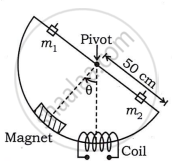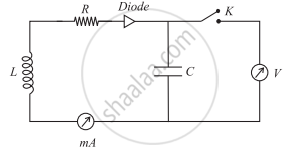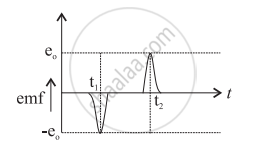Advertisements
Advertisements
Question
With the help of a neat labelled diagram, obtain an expression for the induced emf in a stationary coil in a changing magnetic field.
Solution

Fig. (a): Magnet-coil system

Fig. (b) : Measurement of induced emf
 |
 |
| Fig. (c): Variation of `vecB` with time t, | Fig. (d): Variation of e with time t. |
A permanent bar magnet is installed on an arc of a semicircle with a radius of 50 cm in a magnet-coil system, as shown in fig. (a). The arc is part of a robust aluminium frame and is suspended in the core of the arc so that the entire system can oscillate freely in its plane. A coil of around 10,000 turns of copper wire loops the arc, allowing the bar magnet to freely move over it.
A capacitor (C) and a diode (D) are connected across the coil to detect the induced emf [Fig. (b)]. As the magnet in the middle of the arc [Fig. (a)] advances across it and recedes, the magnetic flux through the coil changes from a small value to a maximum and then back to a small value, inducing an emf.
The variation of magnetic field `vecB` ·(at the coil in mean position) with time is shown in Fig. (c).
`e = - (dphi)/dt` ...from Lenz' law
It follows that emf (e) is 'negative' when Φ increases at time t1 and 'positive' when Φ decreases at time t2.
The diode in fig. (b) will only conduct during the positive pulse. The capacitor will charge to a potential of e1 during the first half swing. There is no conduction in the next half until the next positive pulse arrives and charges the capacitor to e2. This continues until the voltage/emf pulse charges the capacitor to its max value e0.
The equation for induced emf can be written as,
`e = |(dphi)/dt| = |(dphi)/ (dθ)| . |(dθ)/dt|` ...(i)
At θ = 0, the mean position, Φ is maximum.
`(dphi)/dt =` 0 at θ = 0
The seconf term `(dθ)/dt` can be deduced from the equation,
`θ = θ_0 sin 2pi vt`
where, θ0 = amplitude of oscillating magnet Frequency, `v= 1/"time period (T)"`
∴ `θ = θ_0 sin (2pi)/Tt`
∴ `(dθ)/ dt = θ_0 cos (2pi)/T t ((2pi)/T)`
∴ `(dθ) /dt = (2piθ_0)/T. cos ((2pit)/ T)` ....(ii)
`|e_0| = ((dphi)/dt)_max = ((dphi)/(dθ))_max. ((2piθ_0)/T)` ....(iii)
The peak induced emf e0 for a particular magnet-coil system is directly related to angular amplitude (θo)and inversely proportional to time period. (T).
